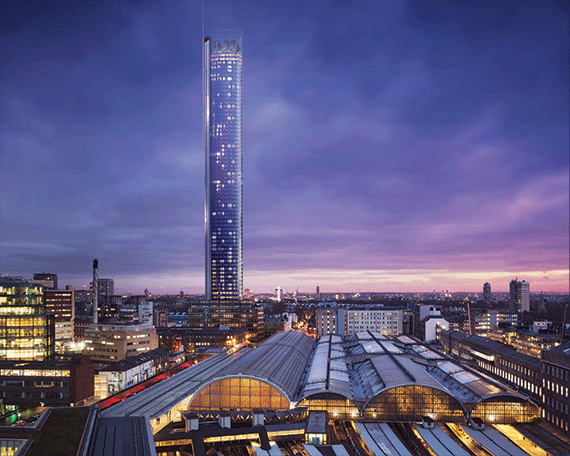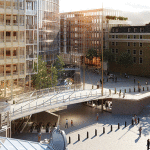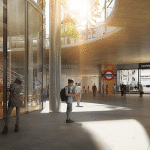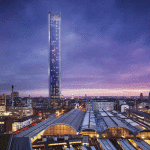An outbreak of batophobia afflicted 40 or so Westminster councillors over Christmas and New Year. What the American Heritage Dictionary defines as “an abnormal fear of being near an object of great height, such as a skyscraper”, has caused developer Irvine Sellar to reluctantly offer to chop a slender 72-storey skyscraper adjacent to Paddington station, W2, to 35 floors – but increase the diameter by 50% to match lost floor space.
Elected members from both the ruling Conservative and minority Labour party confronted council leader Philippa Roe and her deputy Robert Davis in late January with an ultimatum on what has been pejoratively labelled the “Paddington Pole”: “If this skyscraper comes up for decision at the 8 March planning meeting, we will all vote no.” The previously supportive Davis had to confront Sellar with the news.
To date £5m has been spent on the planning application. The new offer turns the 254m pole into an as-yet unseen 124m post, with floor plates of 12,000 sq ft instead of 5,500 sq ft. So what happened? Why? What next? Questions worth asking, if only to understand why a tower designed by one of the world’s most distinguished architects, Renzo Piano, may suffer from being squashed like a stick of Play-Doh.
The case for
The case for a tower is this: Paddington’s mainline and four Tube stations desperately need a new entrance. A modern Crossrail station opens alongside in 2018. This will add to the daily crush and point up the sooty steam age image of the rest of the station. A new 1.2-acre, three-level entrance will cost £100m. Allowing a 500,000 sq ft development above will enable £60m of that bill to be defrayed by developer contributions.
The story of the development begins more than three years ago. In November 2012 Royal Mail obtained permission for a £60m revamp of its 1907 offices beside the station. The 250,000 sq ft scheme planted an eight-storey glass box between partially retained façades. “Passive provision” for an extension to the Bakerloo line ticket office was pretty much all that was on offer.
In autumn 2013 Sellar, his son James, development director Barry Ostle and investment director John Davies held exploratory talks with Network Rail, Transport for London and Crossrail. Not hard to imagine the agenda. “We’ve built the Shard and helped improve access to London Bridge station. If we bought the site and put up a tower, what would be on your wish list to improve access to Paddington?”
The responses were all encouraging. Twelve months later, in October 2014, an offer of £111m was accepted by Royal Mail from Great Western Developments, a joint venture assembled by Sellar. The vehicle is 70% owned by Singaporean hotels billionaire Ong Beng Seng. Architect Sir Terry Farrell was commissioned to work up a masterplan. In January 2016 he was to turn against the development, calling it “opportunistic” and “piecemeal.”
In spring 2015 Sellar appointed Shard architect Renzo Piano. Talks with TfL and Network Rail had led to designs for a new three-level concourse forged by engineer Bill Price of WSP with help from Gerald Eve planning partner Nick Brindley. The only way to help pay for this work was by building up.
And, said Sellar: “We felt it needed an architect of Renzo’s world standing to carry the idea of a tower.”
Designs for a 65-storey tower were worked up by the Renzo Piano Building Workshop. They were unveiled in October. In December another seven floors were added, fuelling criticism. A single distant shot of what looks like a circular pole is the defining image. The cross-section is in fact three shallow linked arches. Attached is a pair of external glass lifts leading to a roof garden.
Piano’s forte
Piano is now 78. The son of a Genovese builder has won all the architectural prizes that matter; the RIBA Gold Medal, the US equivalent, and in 1998, the biggest of them all, the $100,000 Pritzker Architectural Prize. His Genoa studio overlooking the Mediterranean designs art galleries and museums around the globe. In 2006 Piano was lauded by Time magazine for being one of the 100 most influential people on the globe.
But to columnist Sir Simon Jenkins, Piano might as well be just another commercial architect doing the bidding of an avaricious developer. “Now we are told we need the Paddington Pole because starchitect Renzo Piano wants it,” scorned the former chairman of the National Trust in the London Evening Standard last autumn. “The pretence of ‘consultation’ has been a farce,” railed the relentlessly batophobic commentator. “I know of no one locally who has been asked or informed about what is proposed for their skyline.”
Jenkins clearly moves in dinner party circles not attended by the 6,800 local residents and business folk invited to attend exhibitions in October and December. A poll of almost 8,000 commuters produced 70% in favour.
But the spores had been spread. By mid-January, 600 objections had been lodged with Westminster. The plans were pulled on 30 January. Council leader Roe spun the decision thus: “This is a very positive step and will allow time for us all to bring forward a development that enjoys broader community support… We remain committed to ensuring that all the benefits of the original scheme are retained in the revised plans.”
The final sentence is shorthand for “whatever happens, the scheme must contain enough floor space to generate the £60m contribution towards turning the nastiest station concourse in the capital into something more fitting for the 21st century.
Is that going to happen? The fear in the Sellar camp is that halving the height will encourage opponents to go for the kill. Their hope is a stubbier tower will assuage fears.
Westminster’s Labour group leader Adam Hug says he will “wait and see” what the 35-storey development looks like. “But we need to see more than cosmetic changes, not just a squashed tower,” he says.
He adds: “We’d like to see a more effective use of the site. The whole package needs to be looked at.”
The Skyline anti-tower lobby group led by architect Barbara Weiss says: “I am happier, but not happy. We’re not going to give up at 35 storeys.”
Former City chief planning officer Peter Rees, now professor of city planning at UCL, once commended towers, “as they give you longer to make love in the lift”. But he isn’t keen on the pole. “Skyscrapers are a last resort for an already successful business district that has run out of land. They are unlikely to make Paddington vibrant. However big the erection, it won’t impress if you put it in the wrong place.”
Back at the Standard, Jenkins’ hyperbole tends to undermine his eloquence. But one point he made in a second attack on 22 December contains the sting of truth: that Sellar was keen to get permission before a change of mayor. “They have the support of the mayor, Boris Johnson, and his tower-hungry deputy, Sir Edward Lister,” said Jenkins. “They cannot trust either of the new mayoral candidates, Zac Goldsmith or Sadiq Khan, to be sympathetic.”
Correct. The ambivalence in the property industry towards both main candidates is palpable. Khan is seen as unpredictable, Goldsmith as anti-development.
Whatever happens, Sellar and his team will be working to swing public and political opinion in their favour before resubmission in the autumn. The choice of mayor in May will help determine which course of treatment for this outbreak of batophobia will be tried.
Batophobia reaches new heights
Fear of tall towers has reached parts formerly unreachable. Tower Hamlets is this week likely to reject two 65-storey towers at 50 Marsh Wall, E14, on the Isle of Dogs. Planning officers say the scheme, backed by Asian investors, “exhibits clear, demonstrable signs of overdevelopment”. A bit late now, would be the response from anyone walking through the canyon that is now Marsh Wall, part-levelled 20 years ago by an IRA bomb.
The anti-tower movement in London is an odd mix. Genuinely concerned locals make up the grass roots, mostly in the richer boroughs. Their fears are fed by NEIYBYists – as in Not Ever In Your Back Yard groups. Conservation quangos such as Historic England and commentators including former National Trust group chairman Sir Simon Jenkins (see main story) thunder against anything that breaks the local skyline.
In London an anti-tower group called Skyline thrives due to the fact that London lies in the shadow of 260 towers granted planning permission. There is good reason for that. Get hold of a little-noticed report issued by Boris Johnson two weeks ago. Good Growth Agenda goes over the familiar ground about needing 50,000 new homes a year to cope with a population growing at a rate of 100,000 a year.
The document contains two far more interesting facts. The current population density is five times lower than 200 years ago. In 1816, density was about 297 people per hectare. Now it is 73. “If we lived at the 1816 density levels, there would be 35m people in London,” the report points out.
No guesses as to the answer. “Tower blocks can easily reach 1,000 people per hectare — a single tower can contain 600 homes.














